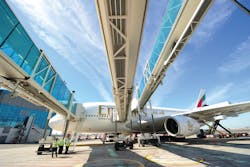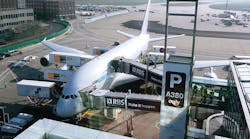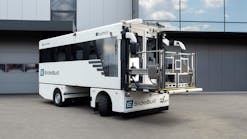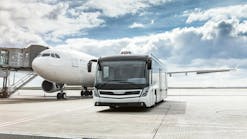Dubai Airport Opens A380 Concourse
The world’s largest customer of the A380 helped inaugurate the world’s first terminal solely designed for the superjumbo jet at the beginning of this year at the Dubai International Airport.
Emirates Airline’s flight EK003 took off from the new concourse to London on Jan. 2. The airline currently operates more than 30 A380s and has another 59 on order.
Concourse A cost $3 billion to build and is just part of the airport’s ambitious plans to establish one of the world’s leading aviation hubs. The airport’s nearly $8 billion Strategic Plan 2020 is designed to provide much needed room as its passenger traffic approaches full capacity. The airport’s annual passenger capacity will increase from 60 million to 75 million when Concourse A becomes fully operational.
The concourse operated with just four of its gates on opening day, but airport management will gradually open all 20 gates.
“We believe that this approach of gradual transition will enable us and all our partners to ensure smooth operations and help us to deliver on our customer service commitment,” said Dubai Airports chief executive Paul Griffiths in a statement.
Operating from a terminal built specifically to handle the A380 will speed up boarding times. Boarding bridges made by ThyssenKrupp factor in the plans to help passengers quickly to get on and off the superjumbo jet.
Michael Ridder from ThyssenKrupp's corporate communications department informed us that 58 of the company's apron-drive, cystal bridge models were delivered for use at the new consourse.
FROM 189 TO 853
A timeline in a 2010-20011 report by ThyssenKrupp shows the growing importance of moving people on and off a plane. Boeing’s 707, the dominant commercial jet during the 1960s, held up to 189 passengers. That figure jumped considerably when Boeing introduced the 747, which could hold 452 passengers. But the A380-800, which Airbus introduced in 2007, can hold up to 853 passengers.
The report recounts some engineering that went into the first A380 boarding bridges. Foremost, of course, is the sheer height of the aircraft.
“The upper door of the A380 is at a height of 8 meters, three meters higher than on other planes, says Marta Munoz Rodriguz, mechanical engineer. As a result, the bridge’s support and lift columns were strengthened.
“The wind at that height is much stronger,” she says, “so we added stabilizers extending out to the right and left to make the bridge more stable.”
To enable some 850 passengers to board and disembark quickly, the ThyssenKrupp bridge docks at all three doors of the aircraft, two for the lower deck and one for the upper deck. This means the tunnels are only about a yard apart so engineers developed an anti-collision system. The company’s first A380 bridge was installed in 2003 at Zurich and Heathrow airports in 2003.
NEW CONCOURSE
Dubai’s new concourse, which spreads across 11 floors with a total area of 5.7 million square feet, will also be available to A380 flights to Europe operated by Australia's Qantas, as per global partnership announced recently and awaiting the approval of the Australian Competition and Consumer Commission, Emirates said.
Later the same week of the opening, the CAPA Centre for Aviation issued a report saying Emirates could become the world’s second-biggest carrier in terms of capacity if the past year’s growth rates are maintained.
CAPA figures show that Emirates had capacity of 4.993 billion available seat kilometers (ASKs) in 2012 compared to 6.15 billion ASKs for United Airlines thanks, in part, to its merger with Continental and 5.64 billion ASKs for Delta Air Lines. Emirates, which started in 1985 with just two leased planes, registered a growth of more than 18 percent in ASKs last year. The current tallies put Emirates will ahead of such European legacy carriers as British Airways with 3.049 billion ASKs and Air France with 2.825 billion ASKs.








